CHEVROLET TRACKER 1995 Owners Manual
Manufacturer: CHEVROLET, Model Year: 1995, Model line: TRACKER, Model: CHEVROLET TRACKER 1995Pages: 354, PDF Size: 18.24 MB
Page 261 of 354
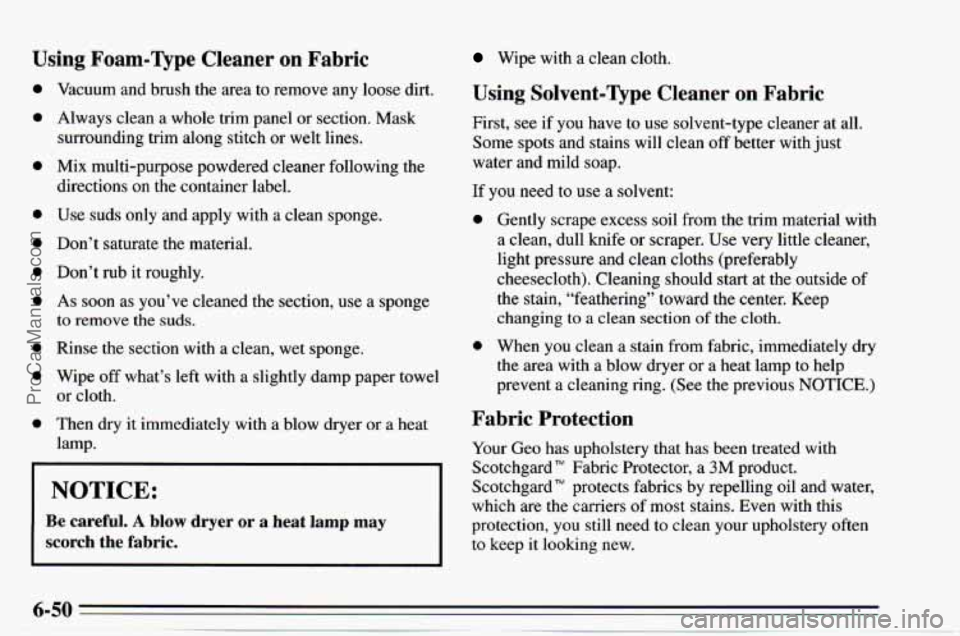
Using Foam-Qpe Cleaner on Fabric
0
0
0
0
0
0
Vacuum and brush the area to remove any loose dirt.
Always clean a whole trim panel or section. Mask
surrounding trim along stitch
or welt lines.
Mix multi-purpose powdered cleaner following the
directions
on the container label.
Use suds only and apply with a clean sponge.
Don’t saturate the material.
Don’t rub it roughly.
As soon as you’ve cleaned the section, use a sponge
to remove the suds.
Rinse the section with a clean, wet sponge.
’wipe
off what’s left with a slightly damp paper towel
or cloth.
Then dry it immediately with a blow dryer or a heat
lamp.
I NOTICE:
Be careful. A blow dryer or a heat lamp may
scorch the fabric.
Wipe with a clean cloth.
Using Solvent-Qpe Cleaner on Fabric
First, see if you have to use solvent-type cleaner at all.
Some spots and stains will clean off better with just
water and mild soap.
If you need
to use a solvent:
0 Gently scrape excess soil from the trim material with
a clean, dull knife or scraper. Use very little cleaner,
light pressure and clean cloths (preferably
cheesecloth). Cleaning should start at the outside of
the stain, “feathering” toward the center. Keep
changing
to a clean section of the cloth.
0 When you clean a stain from fabric, immediately dry
the area with a blow dryer or a heat lamp
to help
prevent a cleaning ring. (See the previous NOTICE.)
Fabric Protection
Your Geo has upholstery that has been treated with
Scotchgard
TM Fabric Protector, a 3M product.
Scotchgard’“ protects fabrics by repelling oil and water,
which are the carriers
of most stains. Even with this
protection,
you still need to clean your upholstery often
to keep it looking new.
ProCarManuals.com
Page 262 of 354
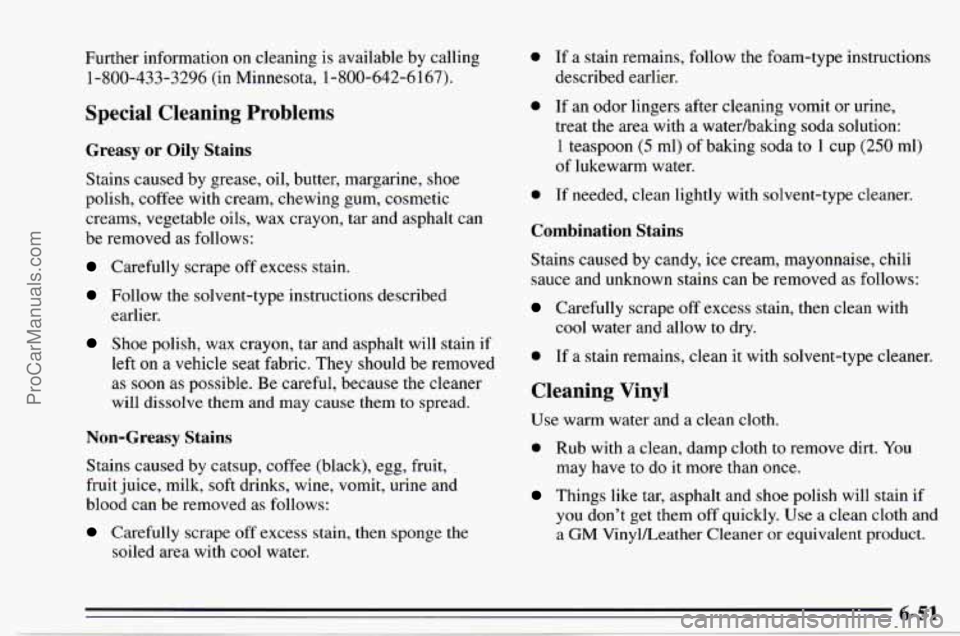
Further information on cleaning is available by calling
1-800-433-3296 (in Minnesota, 1-800-642-6167).
Special Cleaning Problems
Greasy or Oily Stains
Stains caused by grease, oil, butter, margarine, shoe
polish, coffee with cream, chewing gum, cosmetic
creams, vegetable oils, wax crayon, tar and asphalt
can
be removed as follows:
Carefully scrape off excess stain.
Follow the solvent-type instructions described
earlier.
Shoe polish, wax crayon, tar and asphalt will stain if
left on a vehicle seat fabric. They should be removed
as soon as possible. Be careful, because the cleaner
will dissolve them and may cause them to spread.
Non-Greasy Stains
Stains caused by catsup, coffee (black), egg, fruit,
fruit juice, milk, soft drinks, wine, vomit, urine and
blood can be removed as follows:
Carefully scrape off excess stain, then sponge the
soiled area
with cool water.
0 If a stain remains, follow the foam-type instructions
described earlier.
0 If an odor lingers after cleaning vomit or urine,
treat the area with
a waterbaking soda solution:
1 teaspoon (5 ml) of baking soda to 1 cup (250 ml)
of lukewarm water.
0 If needed, clean lightly with solvent-type cleaner.
Combination Stains
Stains caused by candy, ice cream, mayonnaise, chili
sauce and unknown stains can be removed as follows:
Carefully scrape off excess stain, then clean with
cool water and allow to dry.
0 If a stain remains, clean it with solvent-type cleaner.
Cleaning Vinyl
Use warm water and a clean cloth.
0 Rub with a clean, damp cloth to remove dirt. You
may have to do it more than once.
Things like tar, asphalt and shoe polish will stain if
you don’t get them off quickly. Use a clean cloth and
a GM Vinylkeather Cleaner or equivalent product.
ProCarManuals.com
Page 263 of 354
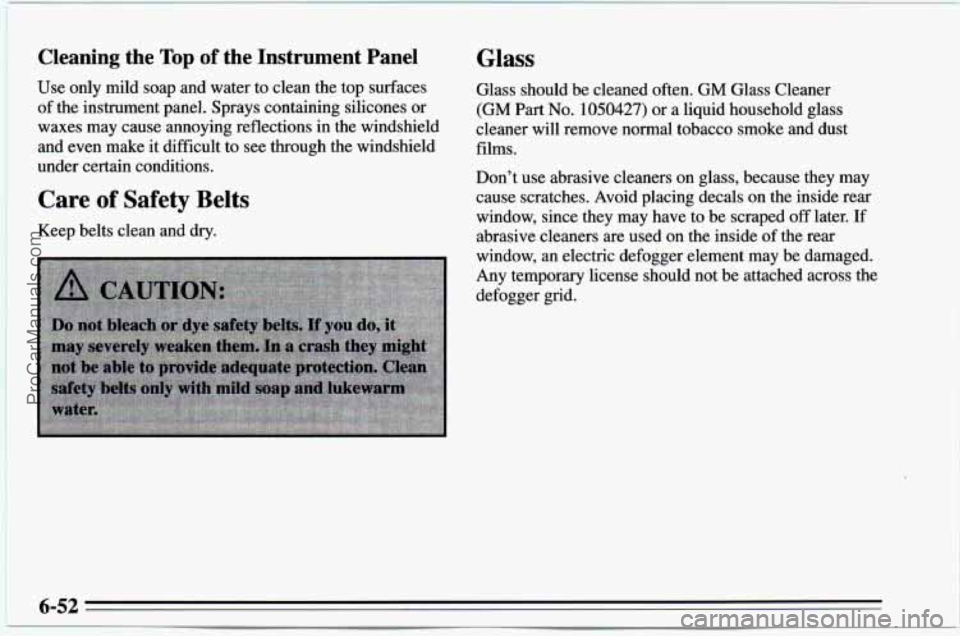
Cleaning the Top of the Instrument Panel
Use only mild soap and water to clean the top surfaces
of the instrument panel. Sprays containing silicones or
waxes may cause annoying reflections in the windshield
and even make it difficult to see through the windshield
under certain conditions.
Care of Safety Belts
Keep belts clean and dry.
Glass
Glass should be cleaned often. GM Glass Cleaner
(GM Part No. 1050427) or a liquid household glass
cleaner will remove normal tobacco smoke and dust
films.
Don’t use abrasive cleaners on glass, because they may
cause scratches. Avoid placing decals on the inside rear
window, since they may have to be scraped
off later. If
abrasive cleaners are used on the inside of the rear
window, an electric defogger element may be damaged.
Any temporary license should not be attached across the
defogger grid.
ProCarManuals.com
Page 264 of 354
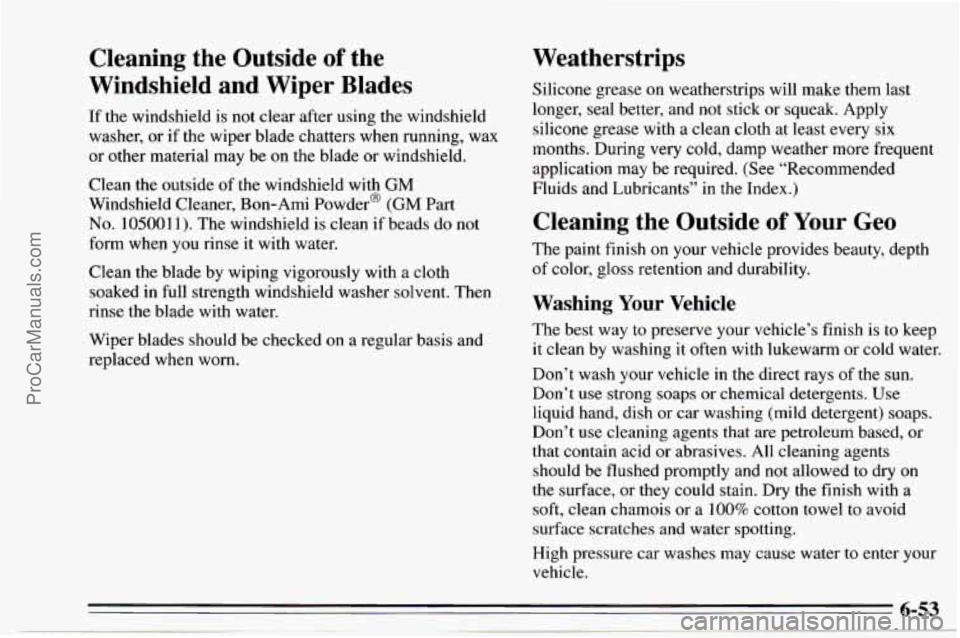
Cleaning the Outside of the
Windshield and Wiper Blades
If the windshield is not clear after using the windshield
washer, or if the wiper blade chatters when running, wax
or other material may be on the blade or windshield.
Clean the outside of the windshield with
GM
Windshield Cleaner, Bon-Ami Powder@ (GM Part
No. 1050011). The windshield is clean if beads do not
form when you rinse it with water.
Clean the blade by wiping vigorously with a cloth
soaked in full strength windshield washer solvent.
Then
rinse the blade with water.
Wiper blades should be checked
on a regular basis and
replaced when worn.
Weatherstrips
Silicone grease on weatherstrips will make them last
longer, seal better, and not stick or squeak. Apply
silicone grease with a clean cloth at least every six
months. During very cold, damp weather more frequent
application may be required. (See “Recommended
Fluids and Lubricants” in the Index.)
Cleaning the Outside of Your Geo
The paint finish on your vehicle provides beauty, depth
of color, gloss retention and durability.
Washing Your Vehicle
The best way to preserve your vehicle’s finish is to keep
it clean by washing it often with lukewarm or cold water.
Don’t wash your vehicle
in the direct rays of the sun.
Don’t use strong soaps or chemical detergents. Use
liquid hand, dish or car washing (mild detergent) soaps.
Don’t
use cleaning agents that are petroleum based, or
that contain acid or abrasives. All cleaning agents
should be flushed promptly and not allowed to dry
on
the surface, or they could stain. Dry the finish with a
soft, clean chamois or a
100% cotton towel to avoid
surface scratches and water spotting.
High pressure car washes may cause water
to enter your
vehicle.
6-53
ProCarManuals.com
Page 265 of 354
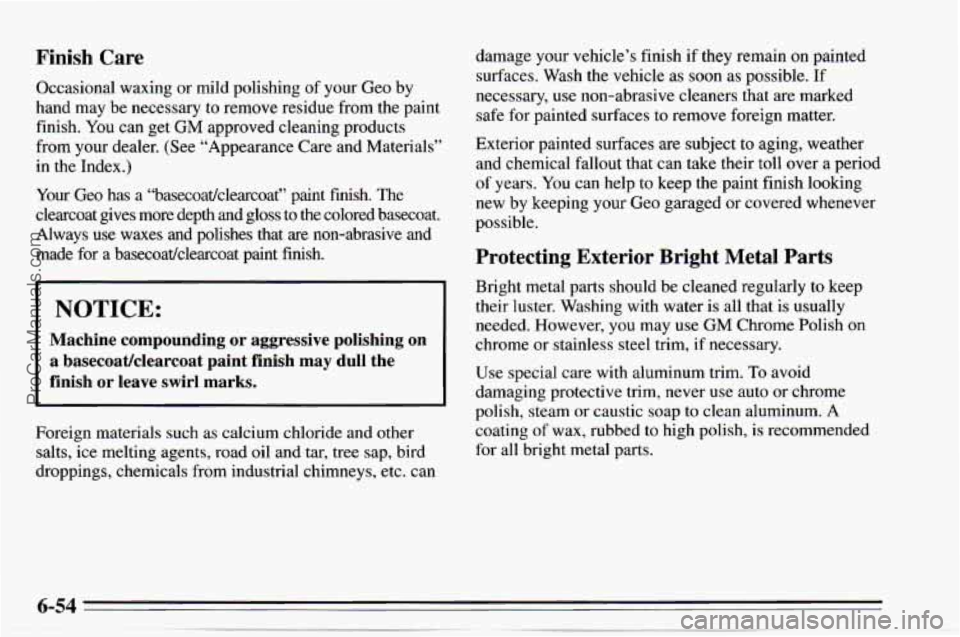
Finish Care
Occasional waxing or mild polishing of your Geo by
hand may be necessary to remove residue from the paint
finish. You can get
GM approved cleaning products
from your dealer. (See “Appearance Care and Materials”
in the Index.)
Your Geo has a “basecoatlclearcoat” paint finish. The
clearcoat gives more depth and gloss to the colored basecoat.
Always use waxes and polishes that are non-abrasive and
made for
a basecoatlclearcoat paint finish.
I NOTICE:
Machine compounding or aggressive polishing on
a basecoat/clearcoat paint finish may dull the
finish or leave swirl marks.
Foreign materials such as calcium chloride and other
salts, ice melting agents, road oil and tar, tree sap, bird
droppings, chemicals from industrial chimneys, etc. can damage
your vehicle’s finish if they remain on painted
surfaces. Wash the vehicle as
soon as possible. If
necessary,
use non-abrasive cleaners that are marked
safe for painted surfaces to remove foreign matter.
Exterior painted surfaces are subject to aging, weather
and chemical
fallout that can take their toll over a period
of years.
You can help to keep the paint finish looking
new by keeping your Geo garaged or covered whenever
possible.
Protecting Exterior Bright Metal Parts
Bright metal parts should be cleaned regularly to keep
their luster. Washing with water is all that is usually
needed. However, you may
use GM Chrome Polish on
chrome or stainless steel trim, if necessary.
Use special care with aluminum trim.
To avoid
damaging protective trim, never use auto or chrome
polish, steam or caustic soap to clean aluminum.
A
coating of wax, rubbed to high polish, is recommended
for all bright metal parts.
ProCarManuals.com
Page 266 of 354
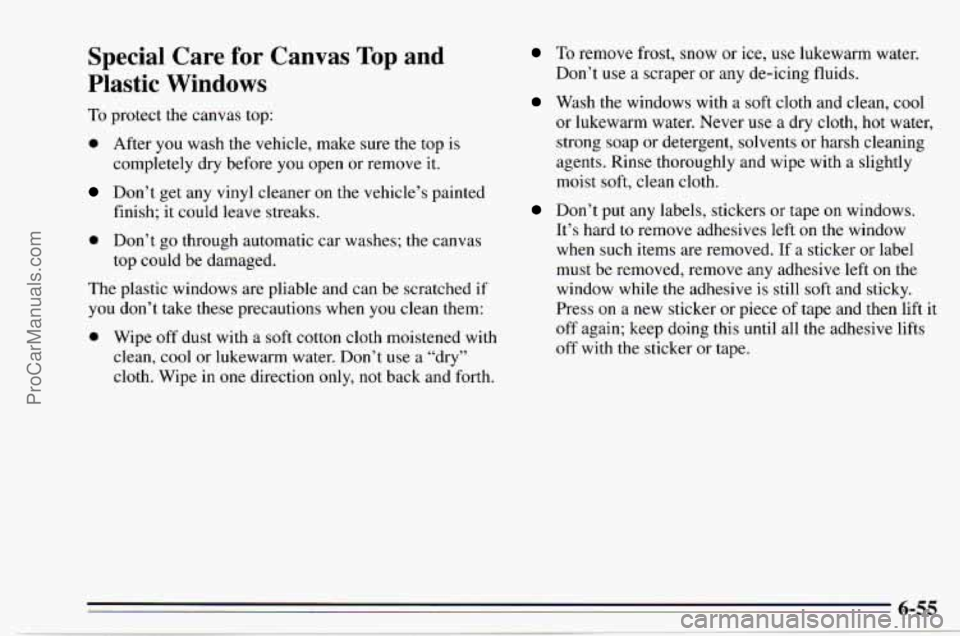
Special Care for Canvas Top and
Plastic Windows
To protect the canvas top:
0 After you wash the vehicle, make sure the top is
completely dry before you open
or remove it.
Don’t get any vinyl cleaner on the vehicle’s painted
0 Don’t go through automatic car washes; the canvas
finish; it could
leave streaks.
top could be damaged.
The plastic windows are pliable and can be scratched if
you don’t take these precautions when you clean them:
0 Wipe off dust with a soft cotton cloth moistened with
clean, cool
or lukewarm water. Don’t use a “dry”
cloth. Wipe in one direction only, not back and forth.
To remove frost, snow or ice, use lukewarm water.
Don’t use
a scraper or any de-icing fluids.
Wash the windows with a soft cloth and clean, cool
or lukewarm water. Never use a dry cloth, hot water,
strong soap or detergent, solvents or harsh cleaning
agents. Rinse thoroughly and wipe with a slightly
moist soft, clean cloth.
Don’t put any labels, stickers or tape on windows.
It’s hard to remove adhesives left
on the window
when such items are removed. If a sticker
or label
must be removed, remove any adhesive left
on the
window while the adhesive is still soft and sticky.
Press
on a new sticker or piece of tape and then lift it
off again; keep doing this until all the adhesive lifts
off with the sticker or tape.
ProCarManuals.com
Page 267 of 354
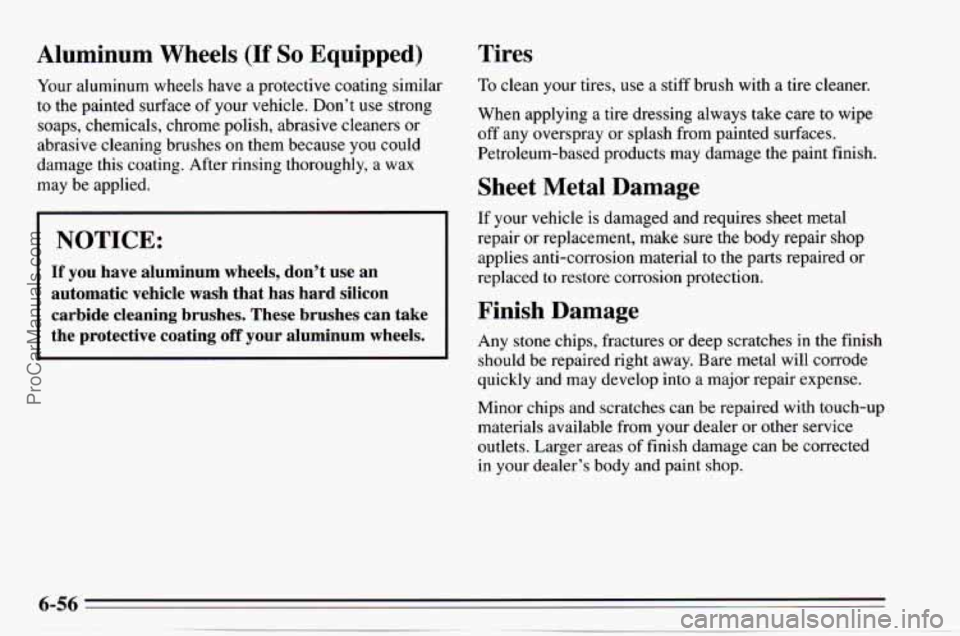
Aluminum Wheels (If So Equipped)
Your aluminum wheels have a protective coating similar
to the painted surface of your vehicle. Don’t
use strong
soaps, chemicals, chrome polish, abrasive cleaners or
abrasive cleaning brushes
on them because you could
damage this coating. After rinsing thoroughly, a wax
may be applied.
I NOTICE:
If you have aluminum wheels, don’t use an
automatic vehicle wash that has hard silicon
carbide cleaning brushes. These brushes can take
the protective coating
off your aluminum wheels.
Tires
To clean your tires, use a stiff brush with a tire cleaner.
When applying a tire dressing always take care
to wipe
off any overspray or splash from painted surfaces.
Petroleum-based products may damage the paint finish.
Sheet Metal Damage
If your vehicle is damaged and requires sheet metal
repair or replacement, make sure the body repair shop
applies anti-corrosion material to the parts repaired or
replaced to restore corrosion protection.
Finish Damage
Any stone chips, fractures or deep scratches in the finish
should be repaired right away. Bare metal will corrode
quickly
and may develop into a major repair expense.
Minor chips and scratches can be repaired with touch-up
materials available from your dealer
or other service
outlets. Larger areas of finish damage can be corrected
in your dealer’s body and paint shop.
ProCarManuals.com
Page 268 of 354
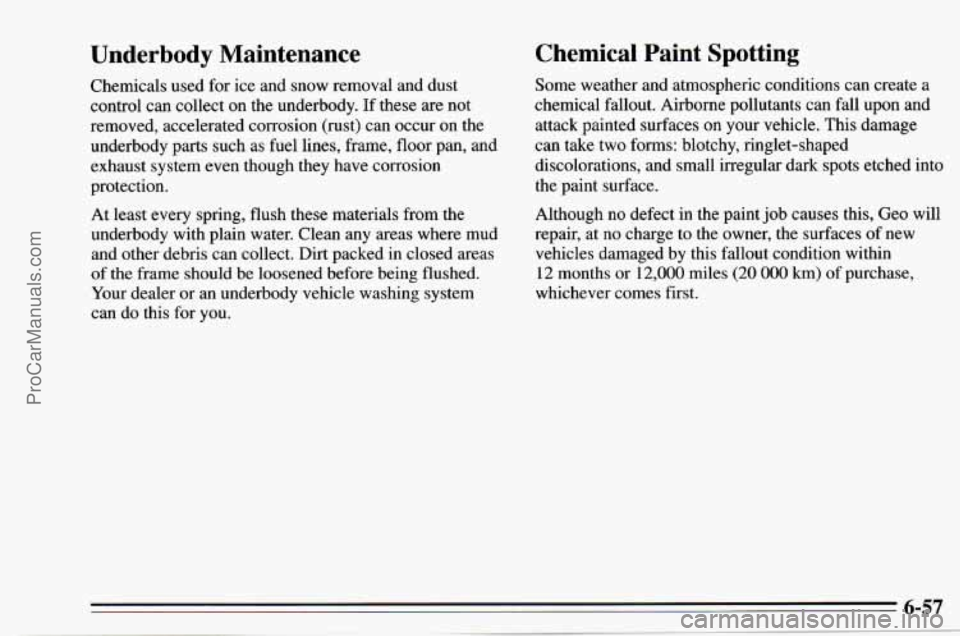
Underbody Maintenance
Chemicals used for ice and snow removal and dust
control can collect on the underbody. If these are not
removed, accelerated corrosion (rust) can occur on the
underbody parts such as fuel lines, frame, floor pan, and
exhaust system even though they have corrosion
protection.
At least every spring, flush these materials from
the
underbody with plain water. Clean any areas where mud
and other debris can collect. Dirt packed in closed areas
of the frame should be loosened before being flushed.
Your dealer or an underbody vehicle washing system
can do this for you.
Chemical Paint Spotting
Some weather and atmospheric conditions can create a
chemical fallout. Airborne pollutants can fall upon and
attack painted surfaces on your vehicle. This damage
can take two forms: blotchy, ringlet-shaped
discolorations, and small irregular dark spots etched into
the paint surface.
Although no defect
in the paint job causes this, Geo will
repair, at no charge to the owner, the surfaces
of new
vehicles damaged by this fallout condition within
12 months or 12,000 miles (20 000 km) of purchase,
whichever comes first.
ProCarManuals.com
Page 269 of 354
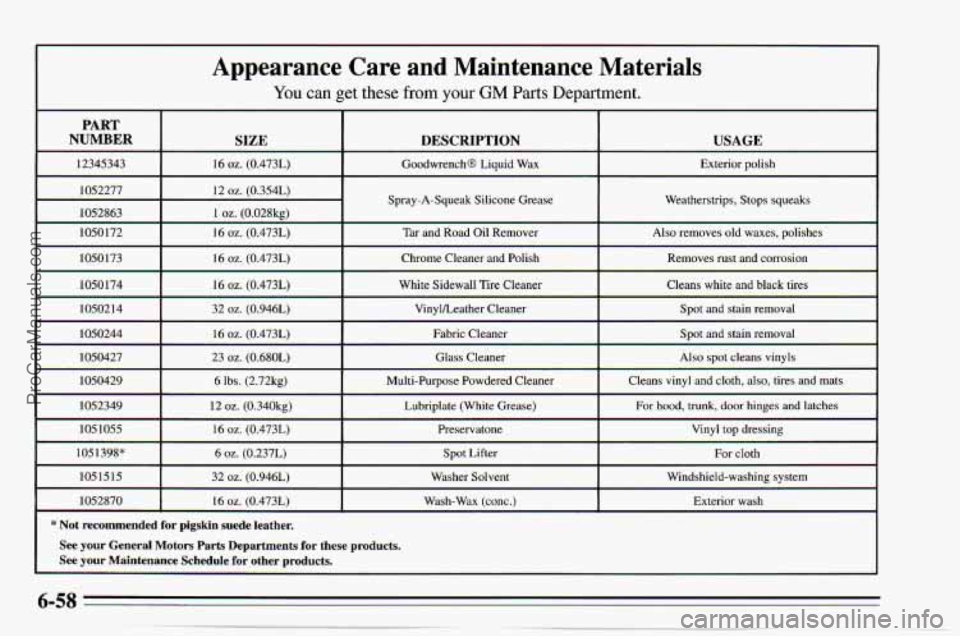
Appearance Care and Maintenance Materials
You can get these from your GM Parts Department.
PART
NUMBER USAGE DESCRIPTION SIZE
Spray-A-Squeak Silicone Grease Weatherstrips, Stops squeaks
* Not recommended for pigskin suede leather.
See your General Motors
Parts Departments for these products.
See your Maintenance Schedule
for other products.
ProCarManuals.com
Page 270 of 354
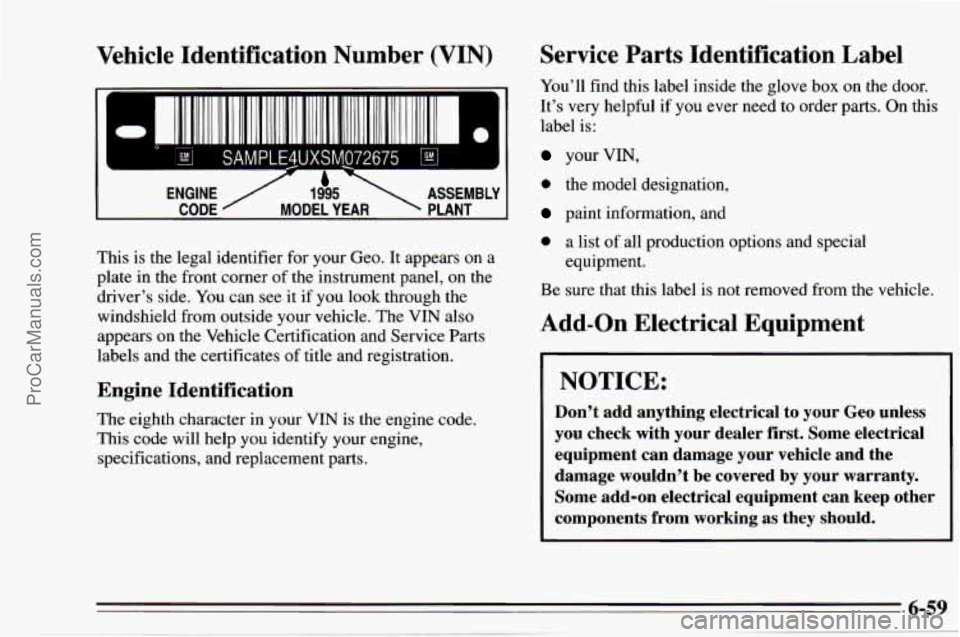
Vehicle Identification Number (VIN)
lli Iiilll Ill1 iilllllilll
1
I
SAMPLE4UXSMJ72675 45s- 1
(. CODE MODEL YEAR PLANT
ENGINE
/ 1995 ASSEMBLY I
Service Parts Identification Label
You’ll
find this label inside the glove box on the door.
It’s
very helpful if you ever need to order parts. On this
label is:
your VIN,
This is the legal identifier for your Geo. It appears on
a
plate in the front corner of the instrument panel, on the
driver’s side. You can see it if you look through the
windshield from outside your vehicle. The VIN also
appears
on the Vehicle Certification and Service Parts
labels and the certificates of title and registration.
Engine Identification
The eighth character in your VIN is the engine code.
This code will help you identify your engine,
specifications, and replacement parts.
0 the model designation,
paint information, and
0 a list of all production options and special
equipment.
Be sure that this label
is not removed from the vehicle.
Add-on Electrical Equipment
NOTICE:
Don’t add anything electrical to your Geo unless
you check with your dealer first. Some electrical equipment can damage your vehicle and the
damage wouldn’t be covered by your warranty. Some add-on electrical equipment can keep other
components from working as they should.
ProCarManuals.com